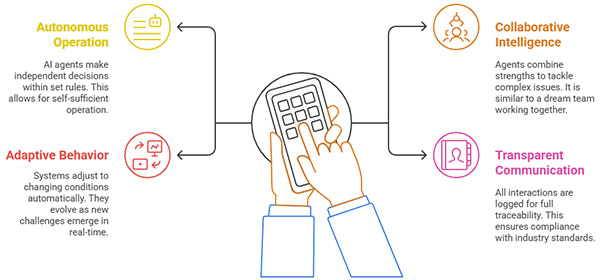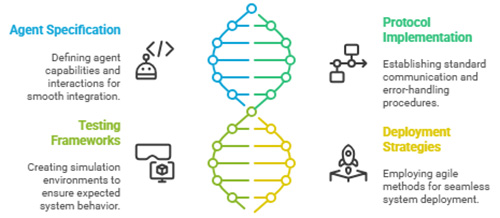Agent Orchestration Engineering - The AI-Powered Revolution Redefining Software Development
- Jun 2025
- 598
- 0

The software world is evolving faster than ever before - and at the heart of this revolution is Agent Orchestration Engineering. By designing and managing systems where multiple AI agents collaborate seamlessly, businesses can unlock new levels of intelligence, speed, and autonomy. As traditional software approaches give way to smarter, more adaptive systems, Agent Orchestration Engineers are leading the charge, shaping the future of business automation and intelligent decision-making.
Ready to dive in? Let’s explore this exciting frontier.
What Is Agent Orchestration Engineering?
Core Definition
-
Agent Orchestration: The art of synchronizing multiple AI agents to work in harmony toward shared goals, creating intelligent workflows that adapt and optimize without human input.
-
Engineering Discipline: A unique blend of AI/ML expertise, software architecture, and distributed systems knowledge—designed to craft systems that think, learn, and evolve.
-
Primary Focus: Building self-organizing systems that automate business processes and solve problems faster and more accurately than ever before.
-
Key Outcome: Autonomous, collaborative systems that can reason, learn from past interactions, and drive measurable business results.
The Principles Behind the Magic
-
Autonomous Operation: AI agents are self-sufficient decision-makers that operate independently within predefined rules.
-
Collaborative Intelligence: Multiple agents, each bringing their unique strength, come together to solve complex problems—just like a dream team in action.
-
Adaptive Behavior: Systems that automatically adjust to dynamic conditions, evolving in real-time as new challenges arise.
-
Transparent Communication: Every interaction is logged, providing full traceability and ensuring compliance with industry standards.

Core Components of Agent Orchestration Systems
Agent Architecture Foundations
-
Individual Agent Design: Tailored AI agents, each with its own capabilities and role in the system.
-
Communication Protocols: Standardized, secure channels for agents to share data and coordinate actions without friction.
-
Decision-Making Frameworks: AI-powered logic systems that help agents evaluate their options and make smart, informed decisions.
-
Memory & Context Management: Intelligent systems that allow agents to learn from past decisions and interactions, evolving over time.
System-Level Components
-
Orchestration Engine: The powerhouse that coordinates agent interactions, ensuring a seamless workflow across systems.
-
Resource Allocation: Smart systems that dynamically allocate computational resources to meet the agents' needs, scaling effortlessly as demand rises.
-
Monitoring & Logging: A comprehensive system to track agent performance, behavior, and outcomes in real-time, ensuring everything runs smoothly.
-
Security & Access Control: Strong safeguards to protect sensitive data and maintain the integrity of the entire system.
The Two Essential Protocols
Model Context Protocol (MCP): Integrating Agents with External Tools
-
Purpose: Empowers agents to connect with external tools, databases, and services, turning them into highly adaptable systems that respond in real-time.
-
Key Capabilities: Real-time data access, dynamic tool discovery, and direct interaction with external services.
-
Why It’s a Game-Changer: No need to redesign systems when new tools are introduced—agents automatically adjust to meet the needs of the business.
-
Example Use Cases: From querying databases to system monitoring, MCP enhances the functionality of every agent.
Agent-to-Agent Communication (A2A): Collaboration Between AI Agents
-
Purpose: Enables agents to communicate directly, share information, and work together toward common objectives—no central command required.
-
Key Capabilities: Goal coordination, shared state management, and conflict resolution, ensuring smooth collaboration across agents.
-
Why It’s a Game-Changer: A scalable, multi-agent system that works across different platforms, organizations, and tech stacks, enabling holistic business automation.
-
Example Use Cases: Solving complex, cross-domain problems in real time—think of it as a team of experts working together, no matter the distance.

Agent Orchestration Design Patterns
Hierarchical Orchestration
-
Structure: A central agent (or master agent) coordinates multiple specialized sub-agents for streamlined operations.
-
Benefits: Easy to manage and debug, with a clear command structure for complex workflows.
-
Implementation Considerations: Potential bottlenecks and a single point of failure need to be accounted for.
Peer-to-Peer Orchestration
-
Structure: Agents communicate directly with each other without a central coordinator, allowing for decentralized decision-making.
-
Benefits: High scalability and fault tolerance make this structure perfect for large, real-time systems.
-
Implementation Considerations: Requires sophisticated debugging techniques to ensure smooth communication between agents.
Hybrid Orchestration
-
Structure: A mix of hierarchical and peer-to-peer elements, combining the strengths of both approaches.
-
Benefits: Flexibility to handle a wide range of systems, offering tailored solutions for diverse business needs.
-
Implementation Considerations: The complexity is higher, and careful design is essential to avoid confusion.
The Technical Implementation Framework
System Architecture Design
-
Agent Identification: Unique identifiers and a clear registry to define each agent’s capabilities.
-
Communication Infrastructure: Efficient message queues and protocol handlers to ensure smooth communication across systems.
-
State Management: Distributed systems that store shared data and context, enabling agents to act on real-time information.
-
Resource Orchestration: Containers and auto-scaling systems that adapt resources based on agent workload demands.
Development Methodology
-
Agent Specification: Defining clear capabilities, inputs, and outputs for each agent to ensure smooth integration.
-
Protocol Implementation: Establishing standard communication and error-handling procedures.
-
Testing Frameworks: Simulation environments that help ensure multi-agent systems behave as expected.
-
Deployment Strategies: Agile methods, including continuous integration and delivery, for seamless deployment of agent systems.

Security, Governance, and Risk Management
Agent Authentication & Authorization
-
Identity Management: Ensure agents have secure, verified identities that align with their role and permissions.
-
Access Control: Assign role-based permissions to limit access and ensure system integrity.
-
Encryption: All agent-to-agent communication is encrypted to safeguard sensitive data.
-
Audit Trails: Every action is logged for transparency and compliance.
Risk Management
-
Behavior Monitoring: Real-time tracking of agent actions to ensure no deviation from expected behavior.
-
Fail-Safe Mechanisms: Automatically shutting down or rolling back the system in case of issues to prevent cascading failures.
-
Data Protection: Stringent security protocols that ensure sensitive data remains protected at all times.
Scaling Agent Orchestration Systems
Horizontal Scaling Strategies
-
Agent Replication: Replicating successful agents to meet growing demand across regions and platforms.
-
Load Distribution: Balancing the workload efficiently across agent clusters to optimize performance.
-
Geographic Distribution: Deploying agents near users and data sources for faster response times.
Vertical Scaling Approaches
-
Enhanced Capabilities: Improving individual agent intelligence for deeper decision-making and faster processing.
-
Memory Optimization: Efficient resource usage for improved system efficiency.
The Future of Agent Orchestration
Emerging Technologies
-
Autonomous Learning: Agents will improve their own capabilities over time without human intervention.
-
Natural Language Interfaces: Making the management of agents easier through voice or text-based systems.
-
Quantum Computing: Unlocking incredible processing power for even more complex systems.
Industry Applications
-
Healthcare: Coordinated patient care and faster medical research.
-
Finance: Real-time automated trading and fraud detection.
-
Manufacturing: Smart factories optimizing every part of the production line.
Agent Orchestration Engineering is not just an evolution of software development—it’s a complete transformation in how systems think, collaborate, and perform. As businesses continue to demand more intelligent, adaptive solutions, the role of Agent Orchestration Engineers will only grow.
Will you be ready to take the reins of the future?



Comments
No comments yet.
Add Your Comment
Thank you, for commenting !!
Your comment is under moderation...
Keep reading blog post